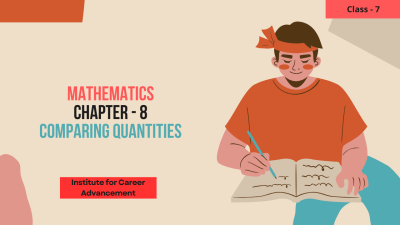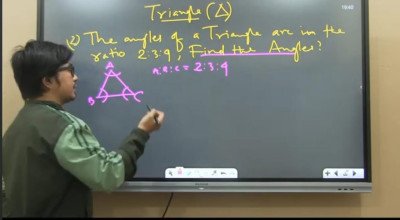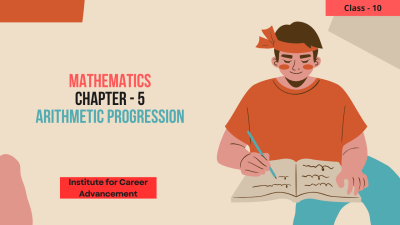Course description
In a class 7 mathematics curriculum, the topic of "comparing quantities" typically involves understanding and applying concepts related to ratios, proportions, percentages, and their applications in real-life situations. Here's an overview:
Ratios and Proportions:
- Ratio: A ratio is a comparison of two quantities by division. It can be expressed in the form ba or as a fraction, where a and b are two quantities being compared.
- Proportion: A proportion is an equation that states two ratios are equal. For example, ba=dc is a proportion.
- Students learn to solve problems involving ratios and proportions, such as finding the missing term in a proportion or using proportions to solve real-life problems.
Percentages:
- Percentage: A percentage is a fraction or a ratio expressed as a fraction of 100. It represents a part of a whole.
- Students learn to calculate percentages, convert between fractions, decimals, and percentages, and apply percentages in various contexts such as discounts, markups, interest rates, and tax calculations.
Profit, Loss, and Discount:
- Students learn about profit, loss, and discount in business transactions. They understand how to calculate profit percentage, loss percentage, and discount percentage, and how to apply these concepts in solving problems related to buying and selling goods.
Simple and Compound Interest:
- Students learn about simple and compound interest and how they are calculated. They understand the difference between them and how to calculate interest over time.
Speed, Distance, and Time:
- Students learn about the relationship between speed, distance, and time. They understand how to calculate speed, distance, or time given the other two variables, and how to solve problems involving motion.
Direct and Inverse Proportions:
- Students learn about direct and inverse proportions. In direct proportion, two quantities change in the same direction, while in inverse proportion, they change in opposite directions.
Applications in Real Life:
- Students apply the concepts of comparing quantities in real-life scenarios such as budgeting, shopping, financial planning, time management, and problem-solving in various fields.
Understanding and applying the concepts of comparing quantities are essential life skills that help students make informed decisions and solve practical problems in everyday life. These concepts also serve as a foundation for more advanced topics in mathematics and economics.
একটি ক্লাস 7 গণিত পাঠ্যক্রমে, "পরিমাণ তুলনা" বিষয় সাধারণত অনুপাত, অনুপাত, শতাংশ এবং বাস্তব জীবনের পরিস্থিতিতে তাদের প্রয়োগ সম্পর্কিত ধারণাগুলি বোঝা এবং প্রয়োগ করা জড়িত। এখানে একটি ওভারভিউ:
অনুপাত এবং অনুপাত:
অনুপাত: একটি অনুপাত হল ভাগ দ্বারা দুটি পরিমাণের তুলনা। এটি আকারে প্রকাশ করা যেতে পারে
????
????
খ
ক
আমি
অথবা একটি ভগ্নাংশ হিসাবে, যেখানে
????
a এবং
????
b তুলনা করা হচ্ছে দুটি পরিমাণ।
অনুপাত: একটি অনুপাত একটি সমীকরণ যা বলে যে দুটি অনুপাত সমান। উদাহরণ স্বরূপ,
????
????
=
????
????
খ
ক
আমি
=
d
গ
আমি
একটি অনুপাত।
শিক্ষার্থীরা অনুপাত এবং অনুপাতের সাথে জড়িত সমস্যাগুলি সমাধান করতে শেখে, যেমন অনুপাতে অনুপস্থিত শব্দটি খুঁজে পাওয়া বা বাস্তব জীবনের সমস্যাগুলি সমাধান করতে অনুপাত ব্যবহার করে।
শতাংশ:
শতাংশ: শতাংশ হল একটি ভগ্নাংশ বা অনুপাত 100 এর ভগ্নাংশ হিসাবে প্রকাশ করা হয়। এটি একটি সম্পূর্ণ অংশের প্রতিনিধিত্ব করে।
শিক্ষার্থীরা শতাংশ গণনা করতে, ভগ্নাংশ, দশমিক এবং শতাংশের মধ্যে রূপান্তর করতে এবং বিভিন্ন প্রসঙ্গে যেমন ডিসকাউন্ট, মার্কআপ, সুদের হার এবং ট্যাক্স গণনাতে শতাংশ প্রয়োগ করতে শেখে।
লাভ, ক্ষতি এবং ছাড়:
শিক্ষার্থীরা ব্যবসায়িক লেনদেনে লাভ, ক্ষতি এবং ছাড় সম্পর্কে শিখে। তারা বুঝতে পারে কিভাবে লাভের শতাংশ, ক্ষতির শতাংশ এবং ছাড় শতাংশ গণনা করতে হয় এবং পণ্য ক্রয় ও বিক্রয় সংক্রান্ত সমস্যা সমাধানে এই ধারণাগুলি কীভাবে প্রয়োগ করতে হয়।
সরল এবং চক্রবৃদ্ধি সুদ:
শিক্ষার্থীরা সরল এবং চক্রবৃদ্ধি সুদ এবং কীভাবে তাদের গণনা করা হয় সে সম্পর্কে শিখে। তারা তাদের মধ্যে পার্থক্য বোঝে এবং সময়ের সাথে সুদের হিসাব কিভাবে করতে হয়।
গতি, দূরত্ব এবং সময়:
শিক্ষার্থীরা গতি, দূরত্ব এবং সময়ের মধ্যে সম্পর্ক সম্পর্কে শিখে। তারা বুঝতে পারে কিভাবে গতি, দূরত্ব, বা অন্য দুটি ভেরিয়েবল দেওয়া সময় গণনা করতে হয় এবং গতির সাথে জড়িত সমস্যাগুলি কীভাবে সমাধান করতে হয়।
প্রত্যক্ষ এবং বিপরীত অনুপাত:
শিক্ষার্থীরা প্রত্যক্ষ এবং বিপরীত অনুপাত সম্পর্কে শিখে। প্রত্যক্ষ অনুপাতে, দুটি পরিমাণ একই দিকে পরিবর্তিত হয়, অন্যদিকে বিপরীত অনুপাতে, তারা বিপরীত দিকে পরিবর্তিত হয়।
বাস্তব জীবনে আবেদন:
শিক্ষার্থীরা বাস্তব জীবনের পরিস্থিতি যেমন বাজেট, কেনাকাটা, আর্থিক পরিকল্পনা, সময় ব্যবস্থাপনা, এবং বিভিন্ন ক্ষেত্রে সমস্যা সমাধানের ক্ষেত্রে পরিমাণের তুলনা করার ধারণাগুলি প্রয়োগ করে।
পরিমাণের তুলনা করার ধারণাগুলি বোঝা এবং প্রয়োগ করা অপরিহার্য জীবন দক্ষতা যা শিক্ষার্থীদের সচেতন সিদ্ধান্ত নিতে এবং দৈনন্দিন জীবনে ব্যবহারিক সমস্যা সমাধান করতে সহায়তা করে। এই ধারণাগুলি গণিত এবং অর্থনীতিতে আরও উন্নত বিষয়গুলির জন্য ভিত্তি হিসাবে কাজ করে।



















